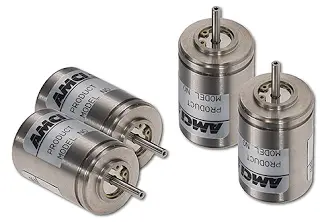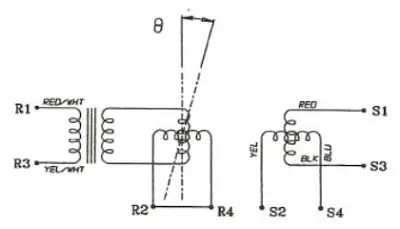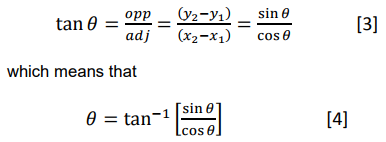 |
| source: designworldonline.com |
Working Principle of Resolver
 |
| Fig1. Resolver |
- The resolver consist of stator and rotor. Stator is the stationary part and rotor is revolving part. A shaft is attached to the rotor.
- The rotor carries the primary winding. The stator carry the two secondary winding displaced angularly offset with respect to one another by 90°. These secondary windings are designated as the sine winding and the cosine winding.
- The basic function of a resolver is to resolve a vector into its sine and cosine components.
- An AC voltage applied to the reference winding in the rotor.
- This inductively couples to the sine and cosine windings, and hence generating an output voltage with a magnitude that varies as the sine or cosine, respectively, of the angular position of the input shaft relative to some zero point.
 |
| Fig.2 |
Consider a right triangle defined by the points (x1,y1), (x2,y1), and (x2,y2) as shown in fig.2. For the angle θ, we can define the side opposite θ as y2-y1, the side adjacent to θ as x2-x1, and the hypotenuse as R. Therefore, we can write as
We can define a circle with radius of R in Cartesian coordinates as R2 = X2 + Y2 as shown in fig.3. Using identities in equations 1 and 2, we can express any point (X,Y) on a unit circle (R = 1) as:
 |
| Fig.3 |
 |
| Fig.4 |
Classification of Resolvers
1. Computing resolver
It is used for generating cosine, sine and tangent functions. It also solves geometric relationships.
2. Synchro resolver
It is used for data transmission. It has same functions as synchro transmitter, receiver and control transformer but with a better accuracy.
Applications of Resolvers
1. Phase shifting
2. Vector composition
3. Vector resolution
4. Vector angle & component resolution
5. pulse amplitude control & pulse resolution



This was an incredibly insightful post! I never realized how crucial resolvers are in various applications. The detailed explanation of their working principle made it much easier to understand. Looking forward to more content like this!
Great insights on resolvers! I found the explanation of their working principle really clear, and the applications section was particularly informative. It’s amazing how they are used in everything from robotics to aerospace. Looking forward to more posts like this!
Great insights on resolvers! I found the explanations of their working principles very clear, and the applications you highlighted really showcase their versatility in various industries. Looking forward to more posts on related topics!